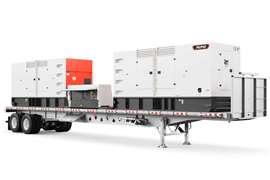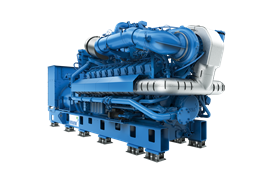Read this article in Français Deutsch Italiano Português Español
Milestone hit for autonomous drilling
27 June 2024
Caterpillar, Thiess and WesTrac collaboration surpasses 1 million meters autonomously drilled
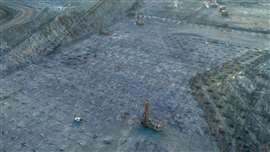 An aerial view of the drill pattern at Mt. Arthur South in Australia. (Photo: WesTrac)
An aerial view of the drill pattern at Mt. Arthur South in Australia. (Photo: WesTrac)
In April, Caterpillar, Thiess and WesTrac officials gathered at the Mt. Arthur South coal mine in New South Wales, Australia, to celebrate a milestone in autonomous machine operation that was three years in the making. Global mining services provider Thiess surpassed 1 million meters autonomously drilled using Cat MineStar technologies installed on a Cat MD6250 and two Cat MD6310 drills.
Currently with Thiess at its mining operations at Mt. Arthur South mine in NSW, the three fully autonomous drills are managed by a single operator sitting in a remote operating station (ROS) using Cat MineStar Command for drilling.
The journey toward autonomous drilling at the mine didn’t happen overnight. According to Caterpillar, a multistep evolution toward automation saw the three companies implementing a building block approach beginning with the MD6250 drill. This required close collaboration between Thiess, WesTrac and Caterpillar, not only to implement technology but also to develop processes specific to autonomous operations, work through change management and develop new training programs for site personnel. These processes helped Thiess move from staffed to autonomous owning and operating procedures for the drills, including safe work procedures.
“Thiess’s commitment to this project and openness for deep collaboration has been a driving force behind its success,” said Sean McGinnis, vice president and general manager of technology and global sales support for Cat MineStar Solutions. “We worked closely with Thiess and WesTrac to ensure our autonomous solution would meet their key performance indicator goals along the way.”
“We are proud to be a leader in automation and autonomy for mining services, said Thiess Head of Autonomy and Operations Technology Trent Smith. “WesTrac did an outstanding job managing the project and providing onsite support to assist us with technology implementation, training and navigating the hurdles – including those posed by the global pandemic – encountered along the way.”
As the three companies worked together to evolve operations toward autonomous drilling, results reported by Thiess include:
- 20% improvement in drilling performance.
- More than 23 hours per day drill utilization.
- Zero redrilled holes using autonomous operation.
- Improvement in safety and reduction in fatigue by removing the operator away from the drill, noise, vibration and dust.
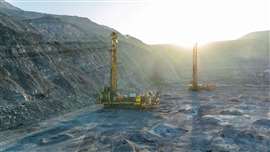 Two Cat MD6250 drills shown at work at the Mt. Arthur South mine. (Photo: WesTrac)
Two Cat MD6250 drills shown at work at the Mt. Arthur South mine. (Photo: WesTrac)
Building block approach
Thiess’s path toward the drilling milestone began in the fall of 2021 with the MD6250 entry level assist technology.
“The phased approach progressed through three stages of drill automation,” said Nakia Brewer, technology and solutions manager for WesTrac, “operator machine assist (OMA), semi-autonomous drilling, and full autonomous drilling with collision avoidance.
Caterpillar offers levels of autonomy as a building block approach to autonomous drilling. The drills, with on-board and expanded Cat MineStar technologies, provide a range of capabilities that enable drilling systems to be configured to meet budgetary and site needs.
The journey into autonomous drilling begins with onboard Drill Assist automated functionality, which is broken into three machine functions:
- Auto Level – provides machine leveling and monitors conditions to ensure it can adjust or lock out if there is an issue.
- Auto Mast – the drill independently raises the mast to the ideal angle for the drill pattern.
- Auto Drill – eliminates over- or under-drilling by enabling configurations for site- and ground-specific parameters like hole diameter, depth and drilling method.
McGinnis said Auto Drill assumes a greater level of complexity and is available for rotary and down-the-hole (DTH) drilling modes, and in single- or multi-pass applications.
“Under most geological conditions, Auto Drill technology enables drilling without operator intervention and monitors and reacts to complications like clearing a hole that has elevated fall back,” he said. “Due to variations in cutting tools used and ground conditions, our drills use onboard drilling algorithms to adapt to and work through complicated ground conditions without operator input.”
Further automation
Cat MineStar Solutions continues the journey to autonomy. MineStar Terrain for drilling provides precision guidance to help complete patterns accurately and productively.
Cat MineStar Command for drilling is the final autonomy building block. Early in the program, Thiess equipped the Cat MD6250 with OMA technology, which leverages Terrain for drilling and its existing network backbone to gain operator buy-in and start seeing the benefits of autonomous drilling, while keeping their operators on board the drill. OMA allows the operator to select a row, and the machine automatically navigates from hole to hole and drills each one in that selected row. It leverages Drill Assist auto functionality, the GPS and navigation package of Terrain for drilling.
“OMA increases productivity and positional accuracy of the tramming, ensuring the drills consistently match design, which goes a long way in instilling confidence in the system,” said McGinnis.
“After installing OMA on the MD6250, we immediately saw the value of the technology and how it could enable better drilling performance for our operations,” said Smith.
The next step for Thiess was to remove the operator from the cab. Command for drilling offers two levels of autonomous drilling for multiple drills – line-of-sight (LOS) and non-line-of-sight (NLOS). Thiess opted for the NLOS autonomous drilling system using the ROS to position the operator away from the drilling site.
It is from the ROS that the company operates three fully autonomous Cat drills and achieved a first of simultaneously operating the three Cat autonomous drills – a multi-pass MD6250 and two MD6310s equipped with Auto Multi Pass – with one operator.
Beyond the operational benefits of improved and consistent drilling performance, increased utilization, and lower rework costs, Trent Smith cited the significant people benefits gained with the autonomous drill program. “It improves safety for our operators, helps to reduce fatigue by allowing them to take short breaks without interrupting drilling operations, and presents more attractive opportunities for upskilling to work with the latest technologies.”
To date, Thiess has moved more than 30 of its people at Mt. Arthur South from traditional drill controllers to autonomous operators, and a range of other support functions. And more broadly, it has invested in autonomous mining systems training for more than 500 employees.
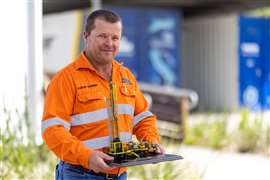 Thiess Autonomy Superintendent Aaron Skinner. (Photo: WesTrac)
Thiess Autonomy Superintendent Aaron Skinner. (Photo: WesTrac)
Full family integration
The MD6250 and MD6310 drills share common platforms, parts, components and technologies. Every drill component and subsystem are matched to work together as a system for increased uptime, greater efficiency and low cost-per-meter drilling, said Caterpillar.
The MD6310 drills hole diameters from 203 to 311 mm (8 to 12.25 in) with single-pass bit loads reaching 42 149 kg (92,922 lb). Single-pass hole depths reaching 13.7 m (44.9 ft) and 17.5 m (57.4 ft) are achieved when equipped with the 13.7 and 17.5 m mast, respectively. Multi-pass hole depths with the 13.7 m mast reach 74.6 m (244.9 ft), while the 17.5 m mast drills down to 48.0 m (157.4 ft).
Reaching bit loads of 32,655 kg (71,993 lb), the MD6250 drills hole diameters from 165 to 200 mm (6.5 to 9.88 in). It can be equipped with either an 11.2 m (36.7 ft) or 13.6 m (44.5 ft) mast. Multi-pass drilling depths reach 53.9 m (176.7 ft) with the 11.2 m mast, while the 13.6 m mast offers up to 37.9 m (124.6 ft) multi-pass depths.
For engines, the MD2650 drill gets a Cat C27 diesel engine rated 872 hp in the U.S. EPA Tier 4 final version, and 826 hp in the Tier 2 model. The larger MD6310 drill rig uses a Cat C32B diesel engine rated 1,007 hp in the Tier 4 final version or 1,031 hp in the same engine built for to meet Tier 2 emissions regulations.
To improve safety and prevent potential failures or misuse, both models are built with proven Cat electronics and interlocks. Electronic compressor regulation boosts productivity while reducing fuel burn. The Cat Electronic Technician provides onboard health monitoring for Thiess for fast troubleshooting to increase drill uptime availability.
“The impressive results achieved with Thiess can be replicated with other miners to improve their operations with drilling autonomy,” concluded McGinnis. “We look to continue collaborating with Thiess and WesTrac and look forward to the millions of meters to come.”
POWER SOURCING GUIDE
The trusted reference and buyer’s guide for 83 years
The original “desktop search engine,” guiding nearly 10,000 users in more than 90 countries it is the primary reference for specifications and details on all the components that go into engine systems.
Visit Now
STAY CONNECTED




Receive the information you need when you need it through our world-leading magazines, newsletters and daily briefings.
CONNECT WITH THE TEAM











